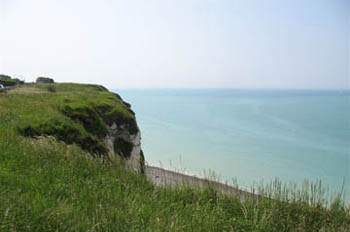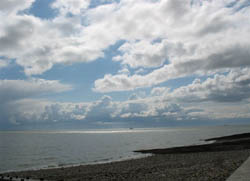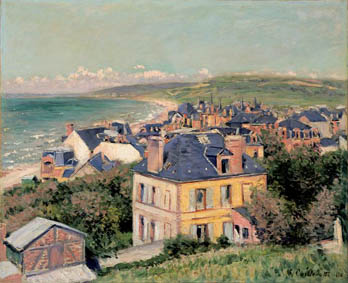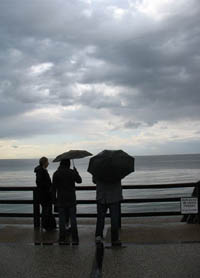|
Making a Wonderful Impression
Normandy Coast, France
by Sarah Shuckburgh
The multi-hued skies of the Normandy coast inspired a group
of painters who changed the way we see the world. Sarah
Shuckburgh follows their steps.
 Normandy skies never stay the same for long. One minute,
cotton-wool clouds float beneath a pale blue dome and the
Channel shimmers in chalky greens; the next, ominous grey
wisps gather into louring mountains over an inky horizon.
Landscape artists discovered this coast from the 1820s -
Huet and Isabey, Turner, Cotman, Corot, Bonington,
Delacroix, Troyon, Millet, Courbet and Mozin. But later
these vast, changeable skies inspired artists such as Boudin
and Monet to abandon conservative methods and to experiment
with sketchy brushstrokes and patches of colour, to capture
transient sensations of wind, vibrations of light,
reflections, shadows and movement - spontaneous impressions
which developed into a new genre of art. Normandy skies never stay the same for long. One minute,
cotton-wool clouds float beneath a pale blue dome and the
Channel shimmers in chalky greens; the next, ominous grey
wisps gather into louring mountains over an inky horizon.
Landscape artists discovered this coast from the 1820s -
Huet and Isabey, Turner, Cotman, Corot, Bonington,
Delacroix, Troyon, Millet, Courbet and Mozin. But later
these vast, changeable skies inspired artists such as Boudin
and Monet to abandon conservative methods and to experiment
with sketchy brushstrokes and patches of colour, to capture
transient sensations of wind, vibrations of light,
reflections, shadows and movement - spontaneous impressions
which developed into a new genre of art.
I decide to explore the coast where impressionism began. My
husband Guillaume was brought up near Dieppe and knows
Normandy well, so he's a useful companion.
We start in Le Havre, childhood home of Boudin and Monet,
and make for the Musée Malraux, with France's biggest
collection of impressionist paintings after the Musée
d'Orsay in Paris. Coastal masterpieces include Monet's pink
'Cliffs at Varengeville', Manet's 'Boats at Sunset' and two
studies of Le Havre by Pissarro, as well as works by Troyon,
Corot, Daubigny, Renoir and Jongkind. The museum owns
hundreds of small, luminous paintings by Boudin, who paved
the way towards impressionism.
Each captures a gust of wind, a sky at dusk or dawn, a storm
brewing, cliffs in sunshine or shadow. Boudin, whom Corot
called 'King of the Skies', painted out of doors, and always
noted the exact time of day and the direction of the wind.
The artists exhibited in Paris, and almost overnight quiet
Normandy fishing villages were colonised by the
haute-bourgeoisie who arrived on newly built railways,
erected ostentatious villas facing the sea, and paraded
along boardwalks which became the 'summer boulevards of
Paris'.

The railway reached Le Havre in 1858, and the town soon
became a fashionable resort, but alas, few villas survived
the Allied bombs which flattened the town in 1944. We walk
along the promenade to neighbouring Sainte Adresse, where
Monet's aunt had a house (destroyed in the war) and where
Monet painted many of his early beach scenes. As we turn
back, the sky turns from hazy grey to thunderous purple, and
clouds pile up above a horizon of startling yellow. Suddenly
torrential rain falls, and we scuttle under the eaves of a
beach hut. Minutes later, the rain stops, the black clouds
move on and the promenade gleams beneath a streaky blue and
pink sky.
It was in Le Havre that Boudin met the teenage Monet, and
persuaded him to stop producing caricatures and take up
painting landscapes 'en plein air'. The Musée Malraux
stands near the spot where Monet painted his 'Impression, soleil levant', a work which provoked ironic and dismissive
criticism when it was first shown - and was the source of
the initially disparaging term 'impressionist'. According to
Guillaume, Monet had poor eyesight, but refused to wear
glasses.
Leaving Le Havre, we cross the Seine on the striking Pont de
Normandie and drive along the left bank to Honfleur. This
medieval town - where Dubourg and Boudin were born - was
miraculously untouched by the Allied bombardment. The old
port survives, with a maze of narrow cobbled streets of
half-timbered and slate-fronted houses. The Musée des Beaux
Arts, founded in 1868 by Dubourg, is now the Musée Boudin,
with a magical collection of Boudin's small masterpieces, as
well as works by Dubourg, Huet, Courbet, Isabey, Mozin,
Jongkind, Cals and Monet.
Several pastel studies by Boudin feature the Ferme Saint
Siméon, a 17th century house on the slopes of the Côte de
Grace above Honfleur. Between 1825 and 1865, la mère Toutain
welcomed artists to her auberge, often accepting
paintings in lieu of rent. Her guests included Isabey, Corot,
Courbet, Bazille, Daubigny, Troyon, Cals, Dubourg, Sisley
and Jongkind, as well as Boudin and Monet - and the inn is
thus intricately linked to the birth of impressionism Today
Saint Siméon is a smart hotel, where we tuck into delicious
oysters and a marmite de poissons.
 Rain lashes against the windows, but the view is still
spectacular - a vast, glittering panorama of estuary and
sky. Rain lashes against the windows, but the view is still
spectacular - a vast, glittering panorama of estuary and
sky.
We drive west through the wooded slopes of the 'Corniche
Normande' to Trouville, the oldest resort on the Côte
Fleurie. Corot, Isabey, Bonington and Mozin painted the
coast here from the mid 1820s, attracting the first holiday
villas. The fad for therapeutic sea-bathing spread here from
Dieppe in 1837, and Trouville became the 'Queen of Beaches',
with segregated sections for men and women, and wheeled
bathing machines which trundled into the sea. During the
1860s, Boudin began to paint holidaymakers at Trouville,
creating, over the next 30 years, a new genre for the
Parisian flâneur - the 'crinoline beach', with bourgeois
figures set against sea and sky.
Monet married at Trouville in 1870, and painted a portrait
of his new wife and Madame Boudin under parasols,
dishevelled by the wind. The canvas is still speckled with
grains of sand. He also painted the Hôtel des Roches Noires,
which, like most hotels along this coast, fell into
disrepair during the Second World War, and is now divided
into flats.
Trouville remains pleasantly low-key and unpretentious, with
a maze of tiny streets, lively quayside restaurants and an
unspoilt beachfront of half-timbered villas (saved from
development by far-sighted mayors). Not so Deauville, its
flashy neighbour across the river Touques, with luxury
hotels and nightclubs, race courses, designer shops and
beautiful people strolling along the famous wooden
boardwalk. Deauville became a resort 30 years later than
Trouville, after a visit in 1859 by the Duc de Morny, half
brother of Napoleon III. But, as Courbet, Boudin and Monet
supplied the Parisian haute-bourgeoisie with paintings, Deauville quickly became the capital of the Normandy
Riviera. It was here that Boudin die d in 1898. d in 1898.
Beyond Deauville, the Calvados coast has long beaches of
smooth sand, backed by the wooded hills, narrow lanes,
hedges and cider orchards of the Pays d'Auge. The sun comes
out as we drive past the 19th century beach-front villas of
Blonville and Bénerville, to Villers-sur-mer, which until
the 1850s was a hamlet linked to Trouville by a footpath
through woods and dunes. The tide is low, and we walk
beneath crumbling black cliffs- the Falaises des Vaches
Noires (fancifully likened to black cows) which are studded
with fossils 150 million years old. Huet and Troyon were
among the first to paint this part of the coast. Caillebotte,
wealthy benefactor of impressionists, also painted here.
The first holiday villa, built in 1854, now houses the
tourist office and fossil museum. The church, enlarged
twenty years later to accommodate summer crowds, has stained
glass windows paid for by wealthy Parisians.
Next we stroll along Houlgate's attractive seafront, lined
with villas in the quirky Anglo-Norman style, with
half-timbering, gables, turrets, towers and fancy coloured
brickwork. As we reach Cabourg, a stately Second Empire
resort built in a fan shape around its casino, the vast sky
fades into the sea in mottled smudges of blue.
Now we drive north, to the windy Côte d'Albâtre, with its
dramatic chalk cli ffs towering above steeply shelved pebble
beaches. Etretat boasts Normandy's most famous rock
formation - a massive headland ending in the Porte d'Aval
'elephant' arch and solitary 200-foot needle. The little
town was once a racy resort, with non-segregated bathing.
The scenery and the ethereal light attracted many artists,
including Corot, Courbet and Boudin. Monet produced a series
of paintings - of which six survive - capturing light, wind,
waves and weather at different times of day. ffs towering above steeply shelved pebble
beaches. Etretat boasts Normandy's most famous rock
formation - a massive headland ending in the Porte d'Aval
'elephant' arch and solitary 200-foot needle. The little
town was once a racy resort, with non-segregated bathing.
The scenery and the ethereal light attracted many artists,
including Corot, Courbet and Boudin. Monet produced a series
of paintings - of which six survive - capturing light, wind,
waves and weather at different times of day.
Here we see our most miraculous skies yet - above a gleaming
horizon, layers of plum-coloured clouds are pierced by
golden shafts of sun. As the storm approaches, holidaymakers
huddle under umbrellas, but out to sea, sunlight glitters on
vivid green waves.
Back on the windswept plateau of the Pays de Caux, an
immense rainbow fills the eastern sky. All along the
Alabaster coast, thickly wooded hanging valleys lead down to
shingle inlets, and we follow one down to Yport, where
Renoir painted the beach at low tide. As clouds scud
overhead, bringing alternate sprinkles of rain and pools of
silvery sunshine, we reach Fécamp, seaside resort and
cod-fishing port painted by Monet and many others, including
Manet and Berthe Morisot.
At Varengeville, several lush valleys cut through high,
crumbling cliffs, and here (on Guillaume's favourite beach)
Monet first experimented with transient impressions,
starting a new canvas whenever the light changed. The next
seaside village, Pourville, is where Monet lived and painted
before moving to Giverny.
We end our voyage de découverte in Dieppe, Normandy's
oldest resort, where the Duchesse de Berry first adopted the
English passion for sea-bathing in 1822. The English artist Bonington encouraged Turner and Delacroix to paint here, and
later, although fashionable Parisians deserted Dieppe for
Trouville, other artists followed, including Boudin and
Monet, Whistler, Gauguin, Pissarro, Sickert, Degas and
Renoir. We trudge along the beach, and when it starts to
rain Guillaume photographs me, dishevelled like Madame Monet
(but older, and under an umbrella instead of a parasol).
Then we head for the clifftop Château Musée, with its
magical paintings of Dieppe by Sickert, Renoir, Pissarro,
Sisley, Isabey, Daubigny. My favourite is Boudin's luminous
painting of chalk cliffs beneath a blustery sky of dappled
white, pale blue and grey.
As we emerge, and head for a restorative Calvados in the
Café des Tribunaux - frequented by artists throughout the 19th century - the chalk cliffs are gleaming with an
ethereal light, beneath a blustery sky of dappled white,
pale blue and grey.
First published by the Telegraph
©SarahShuckburgh |